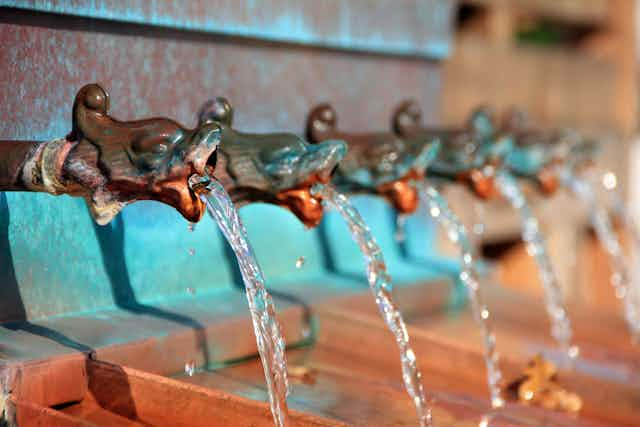Recently, a school project made an alarming discovery: the presence of five times the recommended maximum amount of lead in water samples taken from 14 schools across the UK. Lead is a toxin which even at low levels is capable of affecting children’s brain development and reducing their IQ. The news might well make the British public worry about what exactly is lurking in their drinking water.
Installing lead pipes in the UK’s drinking-water network has been banned for decades, but about eight million old buildings may still have lead pipes in service. Usually, external lead pipes connect the building to the main water pipe, but in some cases, internal plumbing can also contain lead pipes.
Brass plumbing fittings, such as those used in water fountains, can contain low levels of lead and can release that lead if water sits in them for a long time – or if chemicals like chloride make the water corrosive, meaning bits of pipe start leaking into the water. To help prevent this, water companies in the UK add corrosion inhibitors, such as orthophosphate, to drinking water.
Meanwhile, UK water companies are working to identify and remove lead pipes across the country – but this work is slow and expensive. Fundamentally, while lead pipes are in service, there remains a risk of contamination.
Building owners should take action to protect vulnerable people, particularly children, by checking for the presence of lead pipes and testing their water. This can be done by private laboratories, but many water companies will also perform this test if asked to do so.

The US has announced a high-profile infrastructure renewal plan that commits to removing all lead pipes as part of a £39.7 billion water system upgrade fund over the next five years: an example the UK government should consider following.
But lead is not the only contaminant that might be leaking into people’s homes. An increasingly polluted environment means that many contaminants make their way into rivers, lakes and, ultimately, drinking water.
Emerging contaminants
One example of contaminants that have emerged as a health concern in drinking water is a group of chemicals collectively referred to as perfluoroalkyl and polyfluoroalkyl substances (PFAS). Historically used as nonstick coatings for items such as cooking pans and in fire-fighting foams, PFAS can now be found wherever humans live.
PFAS are sometimes called “forever chemicals” because they don’t naturally degrade in the environment, instead they accumulate in the bodies of organisms like fish.
There is considerable scientific debate around the world about how many PFAS can be present in drinking water and food before they pose a danger to human health.
In England, the Drinking Water Inspectorate has set guidance levels for two PFAS compounds: perfluorooctane sulphonate (PFOS) and perfluorooctanoic acid (PFOA). If either compound is detected above 0.01 micrograms per litre of water, water companies must perform a risk assessment, test all their drinking water supplies, and report their findings to local health authorities.

Keeping up with contaminants
The water industry is continually trying to keep up with the latest potential contaminants – including microbiological contaminants including diarrhoea-causing parasites such as cryptosporidium, and ever-increasing volumes of microplastics – to understand where they come from, how to remove them, and what they do inside the human body.
It takes years to study a new contaminant: from determining how best to detect it, understanding how much of it is present in water compared with other sources such as food, and quantifying its effect on public health to justify spending money on regulation.
Drinking water treatment continues to improve, but many of the newer technologies needed to remove contaminants like PFAS require even more energy and chemicals than current methods use. From a sustainability perspective, the best course of action is to prevent these contaminants from entering drinking water sources in the first place.
In the UK, many contaminants are both legally and illegally dumped in waterways in much higher concentrations than are allowed for drinking water. Regulations should be coordinated to make sure that unsafe levels of contaminants don’t get anywhere near the water systems.
Historically, the approach to pollution was to rely on dilution in rivers and lakes to reduce concentrations of potentially dangerous substances. Now, as we understand more about the potential environmental and human health effects of the toxins around us, it’s time to introduce more stringent controls.

